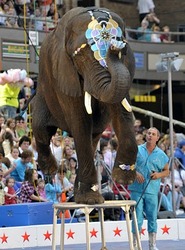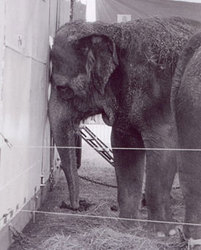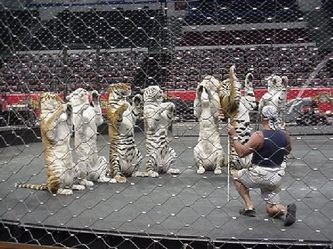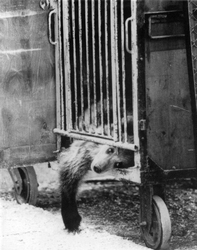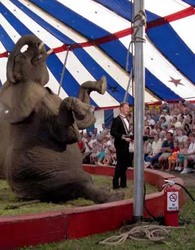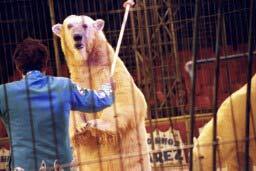Circus Animals
There are 4 circuses that tour Great Britain with a total of approximately 40 wild animals, which include an Asian elephant, tigers, lions, zebra, pythons and Bactrian camels.
Circus animals are subjected to a routine of frequent and extended transport for many months of the year, with regular loading and unloading, training and performance, and housing in small, restricted enclosures. These factors are likely to be stressful to the animals and have significant negative impacts on their welfare. Such conditions would not be allowed even in zoos.
Numerous public polls indicate that around 80% of those members of the UK public questioned thought that the use of wild animals in circuses was not acceptable (2005 MORI poll (Animal Defenders International), 2006 ICM Omnibus poll (Born Free Foundation), 2010 Public Consultation (DEFRA).
Several countries, including Austria, Croatia, Costa Rica, Bolivia, Israel and Singapore, have banned the use of wild animals in circuses. Czech Republic, Denmark, Finland, Portugal, India and Sweden have banned the use of certain wild animals in circuses.
UK incidents
These incidents all involved UK based circuses or circus promoters.
Circus animals are subjected to a routine of frequent and extended transport for many months of the year, with regular loading and unloading, training and performance, and housing in small, restricted enclosures. These factors are likely to be stressful to the animals and have significant negative impacts on their welfare. Such conditions would not be allowed even in zoos.
Numerous public polls indicate that around 80% of those members of the UK public questioned thought that the use of wild animals in circuses was not acceptable (2005 MORI poll (Animal Defenders International), 2006 ICM Omnibus poll (Born Free Foundation), 2010 Public Consultation (DEFRA).
Several countries, including Austria, Croatia, Costa Rica, Bolivia, Israel and Singapore, have banned the use of wild animals in circuses. Czech Republic, Denmark, Finland, Portugal, India and Sweden have banned the use of certain wild animals in circuses.
UK incidents
These incidents all involved UK based circuses or circus promoters.
- Three circus elephants lived chained in a metal container on a ship for a 25,000 mile voyage. The journey took three months.
- A circus promoter was fined £1000 for transporting a lion cub in an overcrowded and unfit container. The cub was found to be paralysed.
- A zebra fell into the sea and drowned after escaping from a circus.
- Inspectors found a performing dog in need of veterinary treatment. Four days later the dog had not been seen by a vet.
- Police found four fully-grown tigers abandoned in a trailer in a layby near Peebles for 16 hours.
- Children screamed and cried, and families walked out when tigers were beaten with sticks during a circus in Surrey. The animals had begun to fight in the ring.
- Police stopped and later prosecuted the driver of a vehicle that was not road worthy. The lorry contained sea lions, and the driver was their trainer. The act toured that season with a well-known UK circus.
Whats wrong with
animal circuses?
The tricks that animals are forced to perform, night after night, are frightening, unnatural, and even painful. Standard circus industry practice is to use bullhooks and other objects to poke, prod, strike, shock, and hit animals in order to "train" them — although this may not be what's seen in the ring or in carefully-controlled public tours.
Circus representatives often claim that animals are only trained to do the types of tricks that they might naturally perform in their native habitat. But common sense dictates that elephants in the wild don't eagerly stand on their heads and that tigers don't naturally jump through hoops.
Animals in circuses spend about 11 months of the year traveling. For thousands of hours, over long distances, they may be chained while not performing, transported in vehicles that lack climate control, and forced to stand or lie in their own waste.
In the wild, elephants live in large, sociable herds and walk up to 25 miles every day. Most other wild animals found in circus settings, including lions and tigers, are also constantly on the move in their native habitats.
Circus representatives often claim that animals are only trained to do the types of tricks that they might naturally perform in their native habitat. But common sense dictates that elephants in the wild don't eagerly stand on their heads and that tigers don't naturally jump through hoops.
Animals in circuses spend about 11 months of the year traveling. For thousands of hours, over long distances, they may be chained while not performing, transported in vehicles that lack climate control, and forced to stand or lie in their own waste.
In the wild, elephants live in large, sociable herds and walk up to 25 miles every day. Most other wild animals found in circus settings, including lions and tigers, are also constantly on the move in their native habitats.
Get Involved!
Visit the following websites where you can help get
involved to banish these animals from UK and overseas
circuses and acts.
http://www.circuses.com
http://www.helpthaielephants.com
http://www.nomoremonkeybusiness.com
http://www.animalcircuses.com
http://www.captiveanimals.org/circuses
involved to banish these animals from UK and overseas
circuses and acts.
http://www.circuses.com
http://www.helpthaielephants.com
http://www.nomoremonkeybusiness.com
http://www.animalcircuses.com
http://www.captiveanimals.org/circuses

